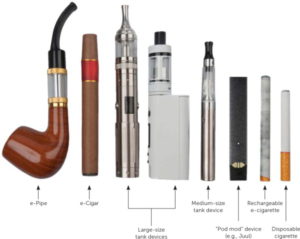By: Joseph Mechak, MD
Vaping (also known as Juuling or e-cigs) is a growing concern in the adolescent population. It has been in the news a lot lately due to serious illness and several deaths linked to these devices. We are concerned about the growing popularity of these devices. We think it is important that you are aware of the facts and dangers of these devices and discuss them with your teen. We wanted to give you information, resources, and a few strategies to facilitate this conversation.
What is vaping?
Juuling and vaping refer to e-cigarette device use. These devices are typically filled with a highly concentrated nicotine cartridge. They were developed as a smoking cessation device but have become very popular among teens. The devices are very small, sleek, and easy to conceal. The vapor is typically odorless, making it easy to do at home or in school without being detected. The nicotine cartridges come in a variety of flavors that are appealing to (and arguably targeted towards) teens. The devices can also be used to smoke illegal THC pods (marijuana oil) that are not regulated in any way.

Trends in Teen Vaping
A recent study published in the New England Journal of Medicine [1] shows concerning trends in teen e-cig use. Between 2017 and 2019, the percent of teens that admit to ever using an e-cigarettes increased from 25% to 40%. Those that admit to using e-cigarettes in the past 1 month also increased from 11% to 25% during the same time period. Since 2011, the vaping rate among teens has increased by 900%! It is now, by far, the most common method of nicotine consumption among teens.
Why is vaping dangerous
Where do we start…
- Nicotine is addictive – The National Academies of Science have found that these devices are highly addictive and that teens that use e-cigarettes are significantly more likely to use actual cigarettes in their lifetime. Many teens do not realize nicotine’s addictive nature when they start using e-cigarettes.
- Nicotine is dangerous to the teen brain – Nicotine at any level is harmful to the developing brain. The United States Surgeon General stated that “no matter how it’s delivered, nicotine is addictive and harmful for youth and young adults”
- Vaping is harmful to the lungs – More on this below…
- E-cig cartridges are a major hazard for accidental injection – Vaping cartridges contain highly concentrated nicotine. If accidentally ingested by a toddler (or any child) it could be extremely dangerous or even fatal.
- E-cigarette cartridges contain harmful chemicals – Vape cartridges contain chemicals like anti-freeze, diethylene glycol, carcinogens like nitrosamines, flavorings that have been linked to lung disease, heavy metals such as nickel, tin, and lead that are harmful at any levels.
- E-cigs can explode – Seriously. There have been cases of injury and burns from e-cig battery explosions or fires.
- THC cartridges are unregulated – THC oils can be harmful to the teen brain (this is a whole different topic). They are also completely unregulated. We have no idea what else these cartridges may contain.
Vaping in the news
There have been over 1,000 illnesses and 24 deaths directly attributed to vaping over the past few months. Many of these illnesses are linked to illegal THC cartridges, but there are also cases linked to typical e-cigarette cartridges. The injuries/illnesses have been varied but most look like a chemical pneumonia caused by unidentified ingredients. Scientists are studying these cases and we are learning more about the causes everyday. For more information, check out this article from the CDC. CDC: Vaping related lung disease
Having a conversation about vaping with your teen
There is no perfect way to start or carry this conversation, but here are a few tips to help the conversation go smoothly.
- Before the Conversation:
- Lead by example! If you smoke cigarettes or e-cigarettes, stop!
- Come prepared: Know the facts and prepare for common questions. Check out a few of these information sheets to get up to speed:
- During the Conversation
- Ask, don’t tell: Open the conversation with questions rather than statements. For example, something like “Is vaping popular at your school?” will likely be better received than “Have you ever used an e-cigarette?”
- Don’t use accusatory language or tone.
- Listen to your teen and be open to their perspectives and experiences.
- Pick a good time: Make sure you and your teen have enough time for where ever the conversation goes. Avoid having the conversation during or following an argument, in times of high stress or when/where there are distractions.
- Be truthful: Avoid false or exaggerated statements. If your teens asks you a difficult question, don’t be afraid to say you don’t know. Then, follow-up and get back to them with the answer.
- After the conversation
- Follow-up: Make sure to close the loop on any unanswered questions or unfinished conversations
- Thank your teen: Talking about vaping was not likely something your teen was looking forward to. Thank them for their honesty and being open to the conversation.
Resources From the Experts:
The CDC, AAP, Surgeon General, and many other professional organizations share our very serious concern about vaping. There are a ton of great resources available. Here are a few links that may be helpful.
If you have any further questions or concerns, feel free to speak to one of us in the office.
DrugFree.org: How to Talk with Your Kids About Vaping
CDC: Talk to your teens about risks of e-cigs
AAP: AAP Policy Statement on Electronic Nicotine Delivery Systems
CDC: e-cigs: what parents need to know
CDC: Risk of e-cigs for Teens
AAP: Statement on Electronic Delivery Systems
References:
[1] Meich, R., et.al., Trends in Adolescent Vaping, N Engl J Med 2019; 381:1490-1491







